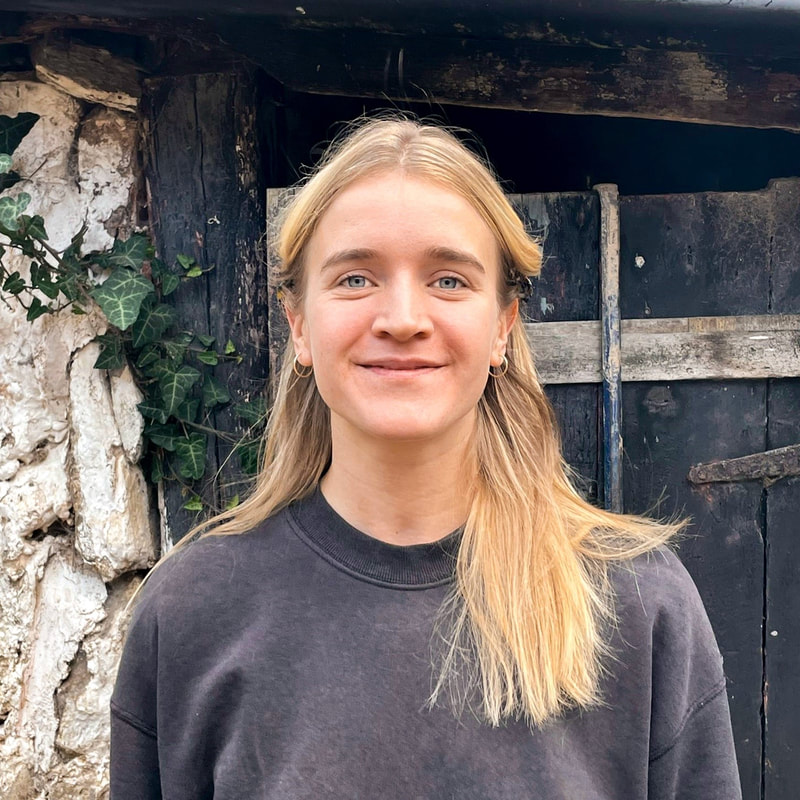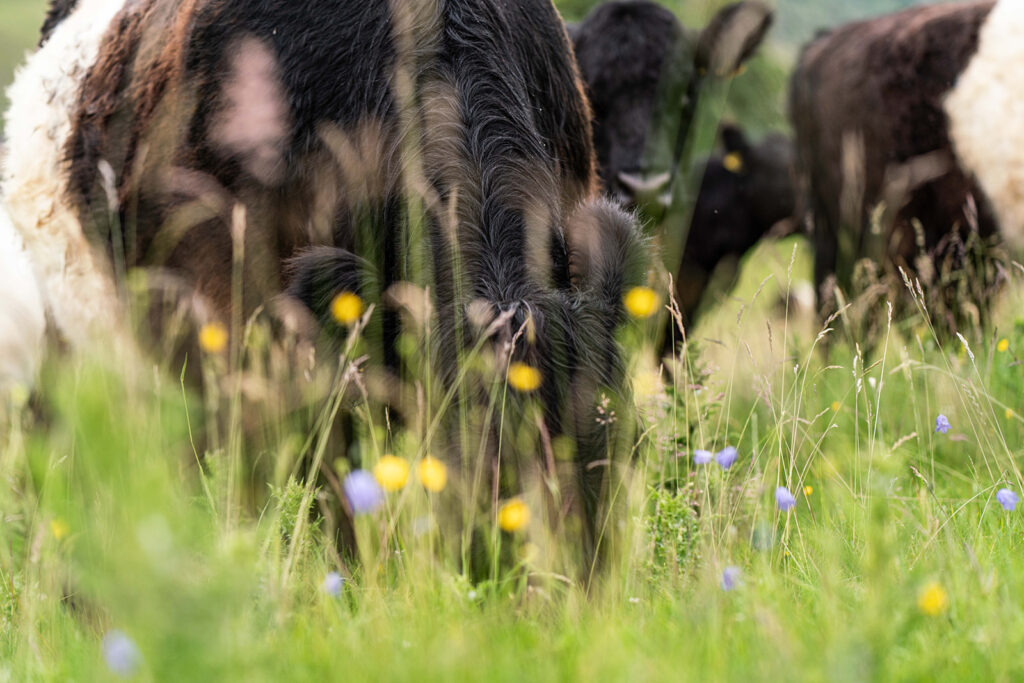Fossil fuels and Farming: Livestock’s role in a low-input future
By Research Officer, Charlotte Wheeler
 (Photo: PfL Research Officer, Charlotte Wheeler)
(Photo: PfL Research Officer, Charlotte Wheeler)
When envisioning a farming system that is fit for purpose for the future we tend to work within existing paradigms, rather than more objectively considering the kinds of radical change that might actually be necessary to stay within planetary boundaries. The dominant paradigm for much of the 20th century has been centred around the concept of “productivity”, aiming for maximum yield and output.
With growing recognition of climate change, this paradigm has been joined by one valorising “efficiency”; this value system manifests itself in strategies that aim to maximise productivity, but facilitate a trajectory towards net zero. However, working within existing paradigms limits the kinds of solutions and strategies we consider viable. Instead, we should critically examine whether these paradigms are a fit foundation to build the food system of the future off of in the first place.
There is a significant and understandable emphasis in the media on the emissions emitted by livestock, but less emphasis on fossil fuel use in agriculture more generally. Perhaps this is because it is considered unavoidable in our modern industrialised food system. These technologies allowed our population to reach over 8 billion; how could such a population possibly be sustained if we move away from them? Not only is this belief misguided, but reducing petrochemical usage and adopting more low-input practices in our farming system more generally brings a series of indirect benefits beyond a simple reduction in emissions. Reducing our dependence on fossil fuels is not only a necessity, it can potentially support our progress towards a more biodiverse, resilient, and food secure future.
The highly mechanised farming practices associated with intensive food systems are dependent on fossil fuels, meaning that agribusiness and the petrochemical industry are profoundly linked. Food-related plastics and fertiliser account for 74% of petrochemical production, and the IEA predicts that by 2050, petrochemical usage will account for half the growth of the oil industry, meaning oil businesses have a vested interest in perpetuating dependency on these products. The Centre for International Environmental Law’s report “Fossils, Fertilisers, and False Solutions” provides a damning indictment of the embeddedness of the fossil fuel industry in commercial agriculture, stating that “Of eight leading fertiliser companies examined for this report, seven showed extensive past or current ties to the fossil fuel industry through board interlocks, corporate ownership structures, or direct engagement in fossil fuel production.” This interdependency reflects a key vulnerability of most farmers in the UK, whose businesses rely on a tenuous globalised supply chain of fossil fuel based inputs such as fertilisers and pesticides, and whose narrow profit margins are less able to weather fluctuations in their price and availability.
While this may seem like an arable issue, intensive livestock systems are also closely linked with agrochemical usage, either when directly applied to grazing land (90% of fertiliser usage in New Zealand is applied to increase grassland productivity for grazing) or indirectly, to grow arable crops as a feed source for livestock (in 2017, soya production in Brazil accounted for 40% of Brazil’s fertiliser consumption). In contrast, through appropriate grazing management of species-rich grasslands and permanent pasture, we can negate the need for synthetic inputs such as fertilisers, or supplementary grain-based feeds. These diverse diets have demonstrated health benefits for livestock, which are carried through into the meat and dairy products we consume in turn. If we were to incorporate agroforestry into these low-input pastured systems , they would have additional climate, biodiversity, and societal benefits, while also making them more resilient to extreme weather.
 (Photo: Pasture for Life certified, Hill Top Farm, Yorkshire, by Gail Caddy)
(Photo: Pasture for Life certified, Hill Top Farm, Yorkshire, by Gail Caddy)
An anecdotal example of this can readily be seen in the events of 2022. The Russian invasion of Ukraine led to an increase in the price of diesel and petrochemical inputs such as fertilisers, feed, and pesticides. That summer the UK experienced a significant drought, which reduced the availability of forage for many livestock farmers, forcing them to feed their winter stockpiles of conserved forage early, or buy in scarce hay at astronomical prices. In contrast, many of the low-input farmers in our Pasture for Life network emerged from the year relatively unscathed. On one hand, their systems were comparatively unmechanized, so they were somewhat insulated from the soaring diesel prices that many farmers had to contend with, either directly or via their contractors. These farmers graze their livestock with the aim of improving the health and diversity of their pastures and soils, leaving taller residuals and longer rest periods. They noted that their pastures were far less affected by the drought than their more intensive or set-stocked neighbours, meaning they didn’t have to dip into winter stockpiles, with the added bonus that their pastures were in better condition going into winter than those that had been significantly set back by the summer’s drought. Although these systems might be less productive in terms of output, they were more resilient, and able to produce in more extreme conditions.
Livestock are integral to a low fossil-fuel food system. Not only do they have the capacity to cycle fertility through arable and horticultural rotations, but integrating livestock into rotations has been demonstrated to reduce pest, weed, and disease burden such as wheat rust or black grass without relying on petrochemical inputs. In this way, it is possible to generate more nutrient value from the same area of land, both due to the second direct “crop” of livestock, but also because their integration actually improves the yield of the primary crop. By integrating livestock with crop rotations and not feeding them dedicated grain rations, we can utilise livestock to serve the needs of arable agriculture, rather than the other way around. This would mitigate competition between livestock and land and resource use.
While organic systems can be less productive than high-input ones, they are still a viable model to contribute to food security; IDDRI’s Ten Years for Agroecology study found that an agroecological and organic food system could feed Europe, even accounting for a drop in productivity. While agrochemicals do not necessarily need to be completely eliminated, their use should be greatly reduced, even if only to ensure long-term and more equitable availability. Assuming the continued existence of the agrochemical industry means recognizing that those farms who do utilise these products can and should do so in the more targeted, efficient, and strategic ways currently being developed by the industry even while we recognise the necessity for reducing their usage overall. One meta-analysis found that incorporating practices such as reduced tillage, intercropping, and livestock manure in arable rotations allowed for high yields while largely substituting for nitrogen fertilisers, while a 2016 study found that out of a list of measures, the two practices with the greatest integrated mitigation-adaptation impact were 1) crop-livestock integration and 2) a reduction in meat consumption showing that this is not necessarily an “either – or” scenario.
If we do not stay within 1.5 degrees of global warming, the conditions that our globalised food production and distribution system will experience over the next 25 years will be radically different to what we are experiencing now. So what are farmers to do? As has been the case throughout history, there are myriad factors outside of their control — there is little that can be done about the cost of diesel, or global supplies of wheat, or supply chain failures. But, as many are recognising, the key is to acknowledge that these crises are no longer anomalies, or one-off periods of bad luck. The new normal will be characterised by volatility and those who base their business models on best case scenarios, or data averages from the past fifty years, are doomed to upheaval. There is no single solution to the ecological and social ills we face in our diverse and globalised society, and organic mixed systems are not a panacea to be implemented universally. But in our highly specialised and technophilic food system, they are consistently undervalued as a potential pathway towards food system sustainability. This is despite the fact that they are compelling as both a strategy for climate change mitigation and adaptation, meaning they are a relatively safe “bet” for farmers interested in increasing the resilience of their land and businesses. It may be that, for many farmers, the transition towards low-input practices is a case of making a metaphorical jump – or being pushed.
Bibliography
1. postcarbon.org/publications/food-and-farming-transition
2. carbonbrief.org/qa-what-does-the-worlds-reliance-on-fertilisers-mean-for-climate-change
3. futureoffood.org/wp-content/uploads/2023/10/ga_food-energy-nexus_report.pdf
4. carbonbrief.org/qa-what-does-the-worlds-reliance-on-fertilisers-mean-for-climate-change
5. ibid
6. sciencedirect.com/science/article
7. nutritionj.biomedcentral.com/articles
8. sciencedirect.com/science/article
9. projectblue
10. tabledebates.org/blog/role-livestock-sustainable-food-system
11. soilassociation.org/media/18074/iddri-study-tyfa.pdf
12. https://pubs.acs.org/doi/10.1021/cen-10115-cover
13. nature.com/articles/s41893-022-00911-x.epdf
14. wires.onlinelibrary.wiley.com/doi/abs/10.1002/wcc.421



